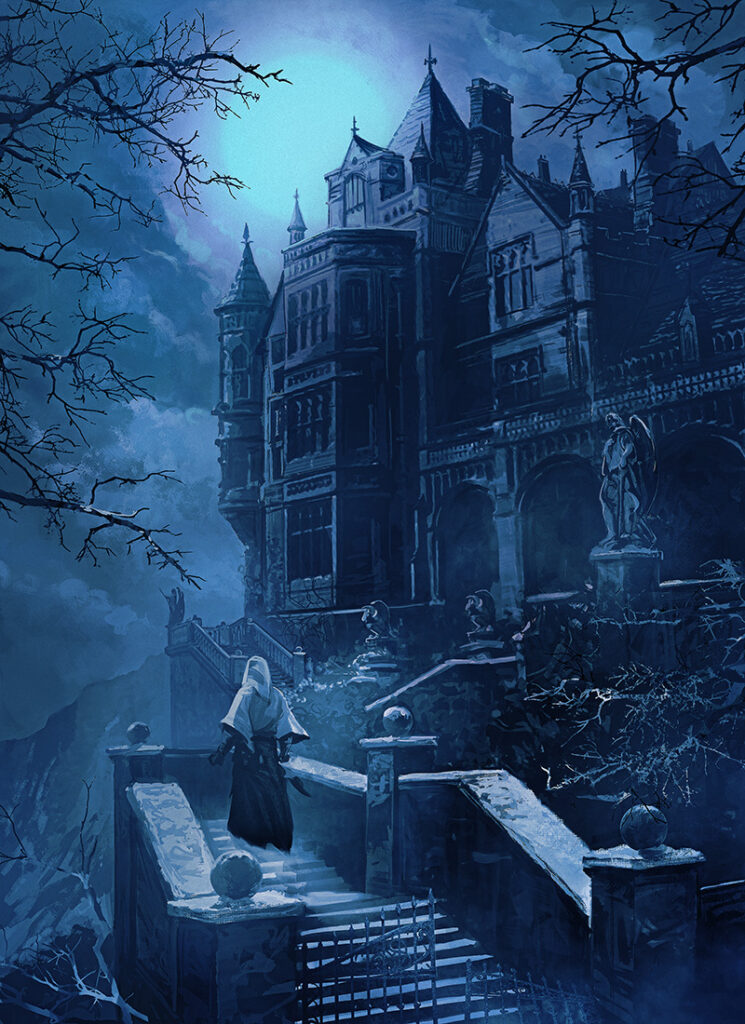
Liminalities crease the world of Curseborne like subtle folds and seams, invisible until you’ve fallen into them.
Liminalities are the “between spaces.” They confuse and disturb anyone who enters them and gives thought to their surroundings. For the pedestrian wearing headphones, keeping her eyes on the floor, just trudging through life, liminalities aren’t at all threatening. This walker can pass through these veils of reality without realizing the ground has shifted beneath her feet. For the scared victim of a stalker, running through an empty parking lot past endless concrete pillars and gloomy shadows, and drumming a relentless clatter of footfalls in a desperate attempt to find an escape, his surroundings are present and pervasive. How easy would it be for the parking lot to turn him around, or for him to disappear into one of those shadows and emerge changed?
The Allure and Threat of Liminal Space
Liminalities can be subtle. Between spaces can be anything from elevators to hotel corridors; strip malls on the highway or the lighting section of a hardware store. These are places you don’t wish to stop unless you truly have a need to do so. Nobody stands in a hotel corridor and admires the art on the walls. Nobody stays at a motel in Middle-of-Nowhere, Texas unless they’re tired and nearly out of gas. And these liminalities can be utterly innocuous in nature. Yes, they unsettle, but there’s no threat to them.
That is, until the Accursed and the many supernatural aspects of the world occupy them. Being between spaces, liminalities act as the perfect places to meet up for illicit liaisons, find a place to call “sanctuary” (if not “home”), prey on victims, or make a deal without having to worry about scrutiny. Curses and pacts feel as if they have more resonance in these places, perhaps due to the existing weirdness in the atmosphere.
Then there are the eerie liminalities. Subway stations and bus stops that don’t appear on a map but beckon you to disembark and explore. Building floors that don’t exist on blueprints but from which one can hear signs of unusual life. Alleys that should be a shortcut to the next block over but drop you somewhere entirely different.
Liminalities give little warning of adjusting from eerie to dangerous. Horrifyingly, the dance floor in this club stimulates the people on it to whip themselves into a dervish culminating as their blood and emotions leech through the ground to feed the liminality. Suddenly, the trail you were following opens out into an unfamiliar city, where the people have no eyes, and the streets are all conveyor belts leading to a colossal machine with a champing mouth. Now, the door won’t open, your windows look out onto nothing but stars, and the fire in this house is rapidly becoming an inferno.
These places have no right existing in our world, and yet through belief, tangled memories, or the actions of the supernatural, they’re brought into being. For observers, liminalities are curiosities that compel them to warn “Don’t get off the elevator on the 20th floor” or “Don’t leave the trail at nightfall.” For explorers, the Accursed, and other supernatural beings, liminalities are phenomena ranging from wondrous to horrifying.
Liminal Varieties
Liminalities come in four common varieties: the “average” liminality that one can enter and exit with just a feeling of disorientation and fear; the interstitial zone that spans wide locations, can alter time, create inhabitants, and wants to cater to those who wander into them (though the way it does so is rarely what humans would consider benevolent); the Battlegrounds where Accursed are forced to be their true selves and rank and file humans are torn to shreds by utterly hostile environments and monstrous denizens; and Shattered Spaces, which like reality-altering pitcher plants want to lure inhabitants in, hold them captive, and slowly devour their minds, emotions, wills, blood, or whatever fulfills the Shattered Space’s appetite.
Humans in the world of Curseborne may be able to sense a liminality’s danger before they step inside. In some cases, it’s as simple as thinking “this elevator looks unsafe and the light keeps flickering, so I’ll take the stairs.” In other cases, however, a liminality such as an interstitial zone or Shattered Space excels at concealing its true nature, and even once a human is caught within, they may be unaware of their captivity. Only someone Accursed feels the change in the air, smells that there’s something off about this stairwell, or knows deep down that entering the empty art gallery would be a very, very bad idea.

Using Liminalities
Storyguides will use liminalities in Curseborne as locations to explore, hideouts for monsters and murderers, environmental terrors from which to escape, and supernatural prisons from which to rescue innocent friends, family, and other associates. Liminal spaces are where the world breaks down, and so they are in many ways the environmental equivalent of an Accursed. Most were normal, once upon a time, and then something changed them. Some, however, were born wicked, just like an Accursed may have inherited a curse without even having to put a foot wrong.
Players will use liminalities as places where discreet deals and pacts might be made, as sanctuaries against persecutors, and sites where the secrets of the world and its darker inhabitants might be located. The Accursed have a mixed relationship with liminal spaces. They represent Eden and Alcatraz simultaneously, as some even provide backdoors to the Outside — purportedly a realm of great wonder — but delving too deep into one is a good way of ensuring you’ll never return to the world you knew.
Liminal Spaces in Media
On the Onyx Pathcast Episode #319 I mentioned that Stephen King is an excellent writer of liminal spaces. A city like Derry (from IT) is like a cross between an interstitial zone and a Shattered Space, as its very wrongness traps its inhabitants while simultaneously corrupting them. Derry invites horrors into the world (in the form of Pennywise and through triggering humanity’s worst instincts) and renders its adult inhabitants utterly oblivious to how awful it is. King explores similar locations, grand and small, in other works including The Shining, Needful Things, 11.22.63, and Fairy Tale (though that one may constitute the Outside), among many others.
But outside of Stephen King’s work, another master of liminal spaces is David Lynch. Lynch plays heavily with locations that exist outside space and time in Twin Peaks (the original TV show, Fire Walk With Me, and The Return) from the out-of-this-world red room (Black Lodge) to the more emotion-bending Band Bang Bar Roadhouse, going all the way to the warped reality scenes of Lost Highway, Mulholland Drive, and Inland Empire, though his exploration of spaces altering people (and people’s minds altering spaces) is in no way limited to those suggestions.
Storyguides and players are encouraged to find liminalities in the media they enjoy and twist them to fit into Curseborne. There’s nothing wrong with using inspirational media in this way, especially as the familiarity of places like the Overlook Hotel will disconcert the players and their characters, which is exactly what liminalities should do.
Example: The Grand Hotel
The Grand Hotel is the city’s oldest, having been built to celebrate a World’s Fair back in the 19th century. It maintains much of the same décor and atmosphere since its founding, including classically trained and dressed butlers, maids, bellboys, and footmen. Staying at the Grand is an opulent novelty where you can be guaranteed a service like none other.
Guests disappear at least once a year but their signature appears on the hotel’s system to record a checkout, so the cops have never got much farther than recording the Grand as several lost individuals’ last known location. The truth is, the Grand is a vast liminal space layered on top of an interstitial zone. It’s frighteningly easy to get lost in the uniformly designed corridors and stairwells (all of them lack numbers to identify where you are) and end up in a populated bar saloon adjoining the guests “new rooms, with compliments from the management.”
In recent years, horror streamers have booked themselves into the Grand to capture footage of purported ghosts and freakish liminal spaces, such as doors that open to walls, staircases leading nowhere, and the spaces where the cranked elevator opens to floors that shouldn’t exist.
The Grand prosecutes unauthorized moviemakers aggressively. Hotel management — Ron Pale and Ronald Hace — first destroy streamers’ recording devices. Then, if they don’t feel the lesson’s learned, they allow these interlopers an extended stay on the fourth floor, which — as far as the public is concerned — has been condemned since 1948. This doesn’t stop footage escaping, of course, and accounts about the Grand are plentiful. All it does is increase the hotel’s legend and attract more visitors.
Many Accursed believe everything about the Grand is a ruse designed to attract the tourist trade, but even if so, it’s possible such foolish toying with curses and mysteries will attract real versions of the same, which the two Rons are unprepared to handle.


Sounds like someone needs to pay the Rons a visit and fix the Grand Hotel!
Last night I was watching Doctor Sleep thinking about the Hurgry and how the hotel is a liminal space. Then American Horror Story come to mind, specially season 5 Hotel, and suddenly we have the Grand Hotel.
By coincidence, Curseborne and Magic: The Gathering’s upcoming modern horror expansion Duskmourn are both using moth imagery.
I had a question about mechanics vs narrative when it comes to Liminal Spaces. Can a Liminal Space have another Liminal Space inside itself? Like, say if a Liminal impoverished neighborhood that weaves and winds it’s way like a maze within a small physical space can have a dead end that leads to a Shattered Space haunted house that wants to trap and digest people?
Can that work with rules as written? Or is there certain features that must stay consistent for a place to be a Liminal Space?
I’d say that it’s absolutely possible to nest liminal spaces and shattered spaces within those liminal spaces. So if you have a whole city block as a liminal space, and it leads to a single house that is its own liminal space that you can only get to from within the other one. Then one room in that house is a shattered space, that would make sense to me.
Awesome! Thanks for the clarification.
Reading about Liminal Spaces reminded me of an idea I’ve toyed with before in other urban horror game lines, and this confirms it can work as written. 😁
Ron Pale and Ronald Hace? Even without going back to check the byline at the top, these two told me that this is a Matthew Dawkins creation!
I do, Ron, Ron.